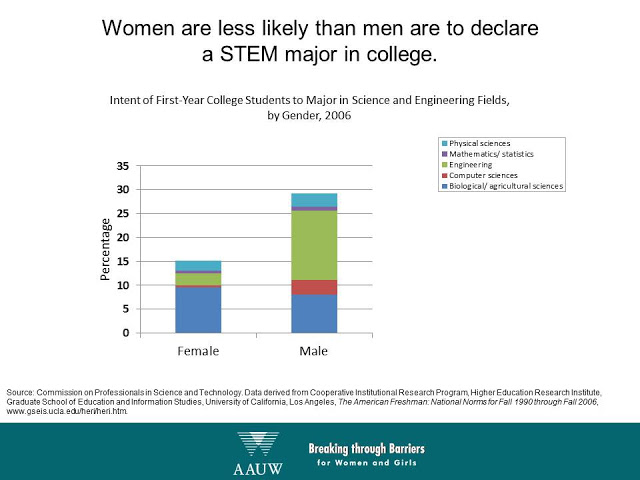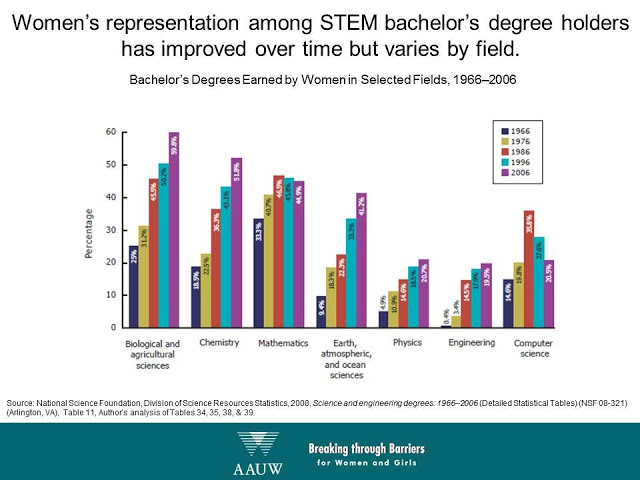Astronomy



- Why Did You Decide On A Phd In Astronomy And Not Physics?
Data from the American Institute of Physics indicate that the fraction of PhDs awarded to women is twice as high in astronomy as in physics. Similar disparities exist at other levels. Note the difference in scales! When thinking about the participation...
- Astro-diversity: Post #1 ? The Pipeline To Astronomy Degrees
Dr. Lisa M. Frehill [1] is an IPA at NSF in Strategic Human Capital Planning working as an Organizational Evaluation and Assessment Researcher. Her home institution is Energetics Technology Center in St. Charles, MD, where she has...
- Why So Few? Scientific Workforce
The 2010 report entitled, Why So Few? Women in Science, Technology, Engineering, and Mathematics, by the American Association of University Women (AAUW), finds that women?s representation in the STEM workforce is uneven. This graph shows the percentage...
- Top 5 Myths About Girls, Math, And Science
LiveScience debunks the top 5 myths about girls, math, and science: The days of sexist science teachers and Barbies chirping that "math class is tough!" are over, according to pop culture, but a government program aimed at bringing more women and girls...
- How To Encourage More Girls To Enter Science?
Women earn the majority of college degrees in the U.S. and, since 2009, the majority of doctorates. This is not the case in astronomy or physics. Why are we different? The American Institute of Physics has studied the enrollments of girls and boys in...
Astronomy
Why So Few? Transition to College

The 2010 report entitled, Why So Few? Women in Science, Technology, Engineering, and Mathematics, by the American Association of University Women (AAUW), finds that despite the overall positive trends in high school, the transition to college is a critical time for young women in STEM. Women are less likely than men are to plan to declare a STEM major in college. In 2006 (the most recent data available), only about 15% of first-year female college students compared with more than a quarter (25%) of first-year male college students planned to declare a major in the physical sciences, mathematics or statistics, engineering, computer science, or the biological/agricultural sciences. If, for a moment, we did not consider the biological/agricultural sciences - indicated here in blue and the STEM area women are most likely to major in - only about 5% of first-year female students intend to major in a STEM area in college.
According to the 2006 American Freshman Survey conducted by the Higher Education Research Institute, only 0.4% of female first-year students planned to major in computer science, compared with 3.0% of males. Also in 2006, only about 3% of female first-year students planned to major in engineering compared with about 15% of their male peers. The physical sciences as listed here include astronomy, atmospheric science, chemistry, earth science, marine science/oceanography, or physics.

Women have earned the majority of bachelor?s degrees overall since 1982. In 2007, women earned 57% of bachelor?s degrees awarded. Women?s share of bachelor?s degrees varies by discipline. The graph above shows the percentage of bachelor?s degrees earned by women in selected STEM fields over the last four decades. The percentage of women receiving degrees in STEM has increased dramatically. For every field except computer science, the trend is upward.
Women?s representation clearly varies by field. In 2006, women earned the majority of bachelor?s degrees in the biological and agricultural sciences. Women earned about half of the bachelor?s degrees in chemistry and math, but women earned a much smaller percentage of degrees in physics, engineering, and computer science. In fact, women?s representation among computer science bachelor?s degree recipients is decreasing. Computer science is a stark reminder that we cannot take women?s progress for granted. In 1986, women earned a third, or one out of every three bachelor?s degrees awarded in computer science; by 2006, women?s share of computer science degrees had dropped to 21% or one out of every five degrees awarded.

There has also been dramatic growth in women?s representation among Ph.D.s in STEM fields over the last four decades. But, again, women?s representation varies considerably by field. The Ph.D. is the ?gatekeeper? credential needed to achieve leadership in academia, as well as for higher-level research positions in government and business, so this is a particularly important indicator. Again, women are best represented among Ph.D. recipients in the biological and agricultural sciences and are significantly underrepresented in computer science, engineering, and physics.
Note: much of this text is from the AAUW ppt describing highlights of the Why So Few? report.
- Why Did You Decide On A Phd In Astronomy And Not Physics?
Data from the American Institute of Physics indicate that the fraction of PhDs awarded to women is twice as high in astronomy as in physics. Similar disparities exist at other levels. Note the difference in scales! When thinking about the participation...
- Astro-diversity: Post #1 ? The Pipeline To Astronomy Degrees
Dr. Lisa M. Frehill [1] is an IPA at NSF in Strategic Human Capital Planning working as an Organizational Evaluation and Assessment Researcher. Her home institution is Energetics Technology Center in St. Charles, MD, where she has...
- Why So Few? Scientific Workforce
The 2010 report entitled, Why So Few? Women in Science, Technology, Engineering, and Mathematics, by the American Association of University Women (AAUW), finds that women?s representation in the STEM workforce is uneven. This graph shows the percentage...
- Top 5 Myths About Girls, Math, And Science
LiveScience debunks the top 5 myths about girls, math, and science: The days of sexist science teachers and Barbies chirping that "math class is tough!" are over, according to pop culture, but a government program aimed at bringing more women and girls...
- How To Encourage More Girls To Enter Science?
Women earn the majority of college degrees in the U.S. and, since 2009, the majority of doctorates. This is not the case in astronomy or physics. Why are we different? The American Institute of Physics has studied the enrollments of girls and boys in...
